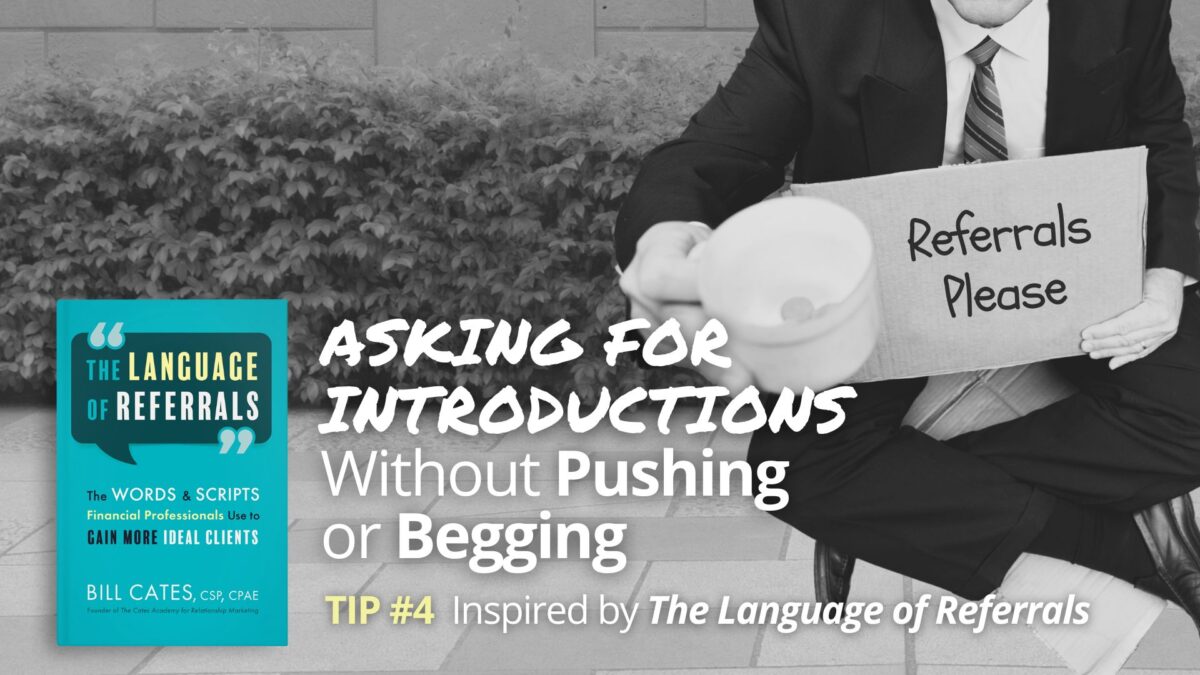Asking for Introductions without Pushing or Begging

The Language of Asking for Introductions
Without Pushing, Begging, or Looking Like The Creepy Referral Guy
Excerpted from Bill’s new book…
The Language of Referrals: The Words & Scripts Financial Professionals
Use to Win More Ideal Clients
This article is Part 4 of a 6-part series. To access parts 1, 2, and 3 CLICK HERE.
When advisors contact me about training and coaching – the one thing I hear most frequently: Is there really a way to ask clients for introductions without looking like that Creepy Referral Guy?
I get it. No one wants to look like that. The good news is that there is a way to ask for introductions without pushing, begging, or running the risk of hurting a client relationship.
The other common thing I hear is: Bill, I know I’m missing a lot of opportunities when it comes to referrals. My clients love me. And I get some unsolicited referrals. If I only had a process that I could apply consistently.
Well… more good news. There is a professional and graceful way to ask for introductions.
In my book, The Language of Referrals, I provide you with a 4-step process I call The V.I.P.S Method. For this article, I’m going to zero in on the last step of that process – The “S” — because this is the part of the process that most advisors don’t usually do particularly well.
The “S” in The VIPS stands for Suggest Names and Categories. When it comes to asking for introductions effectively, the narrower your request the better.
Visualize an archery target. The bullseye in that target represents specific people you know who are in your client’s life. In most cases, these will come from previous conversations with clients as you determine who will be impacted by their financial decisions and people in their life who might make financial decisions that impact them. You also can identify candidates for the bullseye just by being interested and curious about your clients throughout your relationship.
As you move outward from the bullseye, you can brainstorm about life-event and money-in-motion categories. These categories are often just as productive as the bullseye request.
If someone is experiencing a life event (such as changing jobs, getting married, or having a child) or if they have money in motion (such as an inheritance, bonus, or sale of a business or property), their radar for a financial professional may become highly active. They may be looking for someone who can assist them with financial questions, decisions, and overall planning.
Other categories can be groups of people that you know your clients know, such as family members, business colleagues, golfing foursome, or book club members.
Remember, the goal of narrowing this conversation to individuals and groups is to help your source visualize specific people in their mind’s eye so they’ll bring them into the conversation.
Here is an example of what I refer to as a “Bullseye request.”
George, I’m glad you appreciate the important work we’ve been doing together. I know I’ve shared with you that my mission is to help folks make educated financial decisions that are always in their best interest. If you’re open to it, I’d like to brainstorm for a couple of minutes to see who you think should at least be aware of this important work. I have a couple of ideas I’d like to run by you — actually a couple of folks you’ve mentioned in past meetings.
[Oh? Who did I mention?]
Well, in our first meeting, you mentioned that your sister and her husband live in the area. And the last time we met; you talked a bit about your Uncle Ernie. Assuming we can craft an approach that will feel comfortable to everyone, can we discuss possible introductions to them?
[I suppose we I can do that – as long as we handle this carefully.]
This next example demonstrates how you might use categories as the starting point of the conversation such as common life events.
Well, Martha, it’s so nice to hear how much value you feel you’ve received in our worth together. I’m glad we are meeting all your expectations. Every time I speak with Thomas, I thank him for the introduction to you.
Just like Thomas and I did a year ago, I’m hoping you’d be open to spending a few minutes to see if we might identify a few folks who you think should at least be aware of the type of work I do. I actually have a few life event categories to run by you, including the category you were in when we met, to see if it might trigger a few folks to consider. Would you be open to this?
[Categories? What category was I in?]
Well, when Thomas introduced you to me, you were getting serious about finally retiring from your long and successful career. Also, when you and I first spoke, you felt a bit confused about how you were going to start generating income from your 401(k) and other savings and investments.
[Yes, I think that’s true. And I have to say that I no longer feel confused. And, as I see the plan you helped me create unfolding, I’m slowly but surely feeling less anxious. You’ve been a great help to me.]
That’s so nice to hear. Maybe you can visualize some of your co-workers for a minute. Assuming you and I come up with a super comfortable way for you to introduce me to them, who comes to mind as someone who should at least be aware of the work I do?
[Well, I’m pretty close with several women with whom I’ve spent almost my entire career. They know I found someone I like, but we’ve not really discussed anything further.]
I have an idea. How about I take you and your co-workers to lunch sometime in the near future? I can answer any questions they might have. As you know, I’ve become quite versed with your company’s benefits plan. Though the main goal of the lunch will be just to get to know each other a bit, I can follow up afterward to see if any of them would like a complimentary strategy session — much the same way you and I got started. And lunch is on me!
[That’s very generous of you. I have a feeling they will take you up on this offer if you really mean it.]
I do mean it. Let’s discuss how you approach them with this idea to make sure they feel comfortable — as well as spark their interest just a bit.
[Sounds good.]
You may be thinking, “Well Bill… this is all well and good. But what if my client doesn’t want to have this conversation? How do I handle their reluctance or outright objections?”
In Part 5 of this 6-Part series, I’ll be covering The Language of Concerns & Objections. It’s important that you don’t fear a client’s reluctance. And don’t worry, I don’t teach a heavy-handed approach.
And don’t forget ALL our resources – many of them free – are waiting for you at www.ReferralCoach.com/resources.
Start Multiplying Your Best Clients with The Cates Academy™

Learn Bill Cates’ Proven Process to Attract More of the Right Prospects
The Cates Academy for Relationship Marketing™ is a comprehensive online video-training program that will help you generate significantly more income in less time. Work smarter, not harder!
Get the details and join us: www.CatesAcademyIndividuals.com



